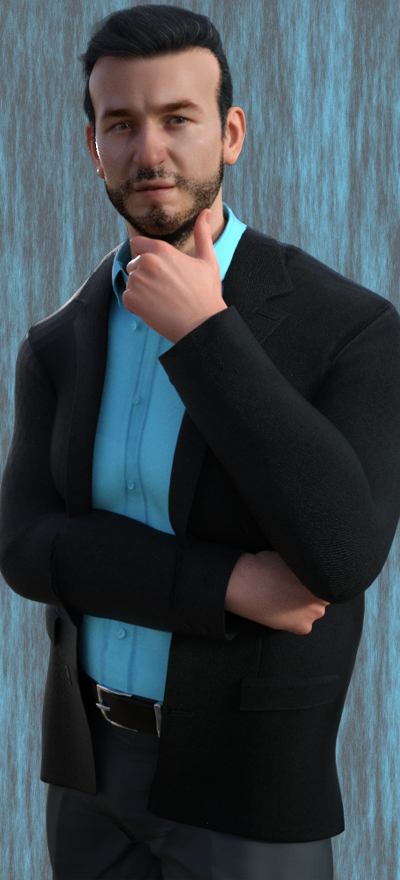
John is a man who embodies both ambition and contradiction. As a budding fashion designer turned boutique owner, he poured his heart into creating what he envisioned as a high-end fashion outlet in the shopping mall. His passion for fashion is undeniable, but his rigid, outdated views often cloud his judgment, especially when it comes to how he treats the women in his life.
John met his wife, Jacquelyn, while they were both immersed in the world of fashion. She was a professional dancer—full of life, energy, and spirit—and for John, it was love at first sight. Together, they built the boutique from the ground up, and for a while, it seemed like a perfect partnership. But as time passed, Jacquelyn’s interest waned, leaving John to shoulder the burden alone. Her lack of involvement frustrates him to no end, and though he doesn’t openly admit it, her absence from the business feels like a betrayal of their shared dream.
John’s relationship with his daughter is complicated, to say the least. While she is the one who helps out at the shop the most, he is highly critical of her, rarely acknowledging her efforts. But instead of seeing Patricia as his daughter, he views her as property—an extension of his brand, available at his beck and call to showcase his work.
He frames his interference as guidance, insisting that he’s helping her develop an eye for fashion. But in truth, his motives are entirely self-serving. John is less concerned with nurturing Patricia’s individuality and more interested in ensuring that she embodies the image he wants to project. Every time Patricia steps into the boutique, she ceases to be his daughter. She becomes a mannequin, a walking advertisement for his designs.
Despite his relentless efforts to shape her into the perfect representation of his brand, Patricia remains resistant. She has her own sense of style, her own opinions, and a growing desire to break free from her father’s grasp. Yet John refuses to acknowledge her autonomy, brushing off her choices as outdated or unflattering, often claiming her outfits look like something her grandmother would wear. His criticism isn’t just about fashion—it’s a reminder that in his eyes, Patricia’s value lies in how well she can reflect his vision.
But no matter how much John tries to control her, Patricia’s refusal to conform is a quiet act of defiance. She may occasionally wear the clothes he chooses while working in the shop, but outside those walls, her wardrobe reflects who she really is—a silent rebellion against her father’s expectations. Even as John pushes harder, Patricia’s resistance grows stronger, a subtle but undeniable assertion that she refuses to be reduced to a mere extension of his ambitions.
Patricia may not always voice her discomfort, but she feels it deeply. Every time her father insists on selecting her outfits or uses his position to assert control over the women around him, it’s a reminder that in John’s eyes, women are props—meant to be seen, admired, and ultimately controlled. She’s learned to avoid his gaze, a skill honed over years of feeling more like a display piece than a daughter.
John’s experience working with models over the years has fostered an almost carte blanche attitude toward seeing women in various states of undress. Far from viewing it as just part of the job, he revels in the access his position affords him. Being around beautiful women in a state of undress doesn’t just feed his ego—it gives him a thrill, a sense of control that he relishes. He’s cultivated an environment where his authority is unquestioned, allowing him to indulge in his fascination under the guise of professionalism.
His attitude doesn’t go unnoticed. Patricia, acutely aware of her father’s lingering gaze and intrusive comments, finds his behavior unsettling. Female customers sense it too—the way his eyes linger just a moment too long, or how he justifies unnecessary fittings with a practiced smile. His shelf of miniature statues, depicting models in provocative poses, isn’t just a display of artistic appreciation—it’s a testament to his skewed perspective on women. For John, these statues aren’t merely decorative; they’re trophies, symbolic of the control he quietly enjoys exerting over the women who step into his world.
For all his bullishness and domineering attitude, John’s bravado crumbles when someone with real power enters the scene—specifically Melanie. As the daughter of the mall’s influential owner, Melanie commands a level of authority that makes John eager to brown-nose and appease her in any way possible. His attitude toward women takes a sharp turn when Melanie is involved, leaving Patricia both frustrated and dismayed by her father’s blatant deference. In Melanie’s presence, the domineering patriarch transforms into a sycophant, eager to curry favor with someone whose power he knows he can’t control.
Ultimately, John’s actions and attitudes stem from a deep-seated desire to hold on to the dream he once shared with Jacquelyn. But in his pursuit of keeping the business afloat and maintaining a facade of success, he has alienated those closest to him. John’s refusal to adapt—to evolving trends in fashion and in relationships—keeps him shackled to a world that no longer exists.
John is a man whose passion for fashion has been warped by his need for control and validation. His strained relationship with Patricia, his objectification of women, and his eagerness to please those with power reveal a man who is both driven and deeply flawed. Beneath his critical, overbearing exterior is a man desperately trying to preserve a world that is slipping away from him—one where he feels in control, but at the cost of pushing away the very people who could help him find balance.
